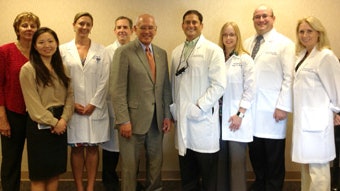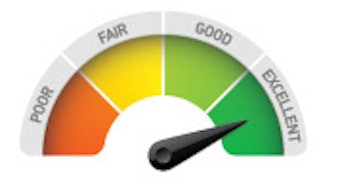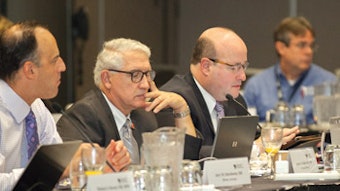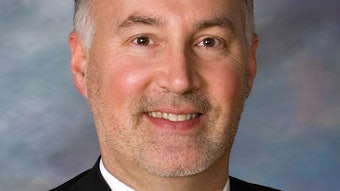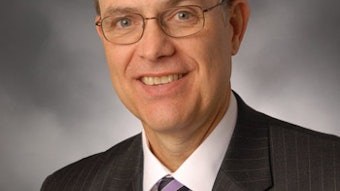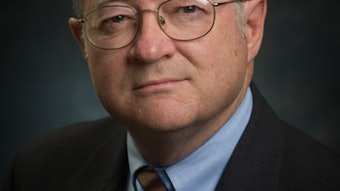Lessons Learned in Honduras
Stephen Nogan, MD Ohio State University On September 7, 2013, I returned from a one-week surgical mission trip to Guaimaca, Honduras, thanks in no small part to the support I received from the American Academy of Otolaryngology—Head and Neck Surgery Foundation. It was a highly successful trip with many patients treated, and the experience laid the groundwork for future international missions in my own career. My first glimpse into international surgical missions came at the age of 20 during my undergraduate studies. I traveled into a Mexican village with 100 strangers and no clear career path, and I left at the end of the trip with many new friends and mentors and a determination to pursue a career in surgery. One of those new friends was David S. Parsons, MD, a pediatric otolaryngologist from Charlotte, NC, whom I joined on several subsequent trips to Mexico and who was the team captain for my recent trip to Honduras. Guaimaca is a municipality in the department (state) of Francisco Morazán in the central part of the country. Honduras has more than 8 million people, more than 50 percent of whom are living under the poverty line and more than 25 percent of whom are unemployed. Guaimaca is no exception to these national statistics. Within Guaimaca exists a hospital, Hospital Bautista, on a mission compound built with private donations and equipped with four brand new operating rooms that Dr. Parsons, Harvey M. Tucker, MD, Robert A. Willis, MD, Christopher L. Tebbit, MD, Tabitha L. Galloway, MD, and I were the first to use. We performed approximately 65 surgeries over the course of four days and distributed hundreds of medications. The operating rooms were fully staffed by U.S. volunteers, and we received additional, incredible support from Honduran physicians, nurses, translators, and security guards throughout the week. Operations included tonsillectomies, adenoidectomies, septoplasties, endoscopic sinus surgery, endoscopic laryngeal surgery, Sistrunk procedures, tympanoplasties, a thyroidectomy, a parotidectomy, and various soft tissue excisions. Having done some limited mission work in the past, the biggest surprise to me on this trip was the quality of the facility. In an area where the local residents had no clean water and inadequate plumbing and electricity, we were able to operate in a facility that met U.S. standards in these capacities. This was truly extraordinary. Because of the high quality of the hospital and, more important, the high character of the Honduran and American volunteers involved, I know we were able to impact the patients in a big way and will continue to do so on future trips. Our friendships with the missionaries and permanent volunteers at the hospital and nearby orphanages will allow us to accurately gauge our impact throughout the coming year and improve the effectiveness of the care we will provide in Honduras going forward. In the big picture of international surgical mission work, there will never be two experiences that are the same, neither in the impact on the volunteer nor the impact on the patients. In many instances, the long-term effectiveness of a short-term experience is difficult to measure, making evaluation and validation of our work challenging. Furthermore, it is impossible to account for all variables in this type of setting. Things like safety, natural resources, medical equipment, and surgical complications can change or arise in an unpredictable fashion, all of which can have an impact on patient care. However, I do believe there are aspects of this type of mission work that you can control. Strong leadership, high character, and loyalty to the cause and the patients are the most important of these and can overcome the inevitable challenges of short-term mission work. Much thanks to Baptist Medical & Dental Mission International (BMDMI), our sponsoring organization, for hosting us during our week in Honduras and the AAO-HNSF Humanitarian Efforts Committee for graciously helping with funding.
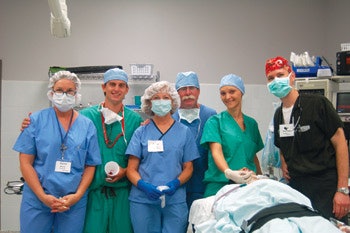 OR Team. (L to R) Carole Brese, Steve Nogan, Susie Willis, Robert Willis, Monica Burciu, and Paul Downing.
OR Team. (L to R) Carole Brese, Steve Nogan, Susie Willis, Robert Willis, Monica Burciu, and Paul Downing.Stephen Nogan, MD
Ohio State University
On September 7, 2013, I returned from a one-week surgical mission trip to Guaimaca, Honduras, thanks in no small part to the support I received from the American Academy of Otolaryngology—Head and Neck Surgery Foundation. It was a highly successful trip with many patients treated, and the experience laid the groundwork for future international missions in my own career.
My first glimpse into international surgical missions came at the age of 20 during my undergraduate studies. I traveled into a Mexican village with 100 strangers and no clear career path, and I left at the end of the trip with many new friends and mentors and a determination to pursue a career in surgery. One of those new friends was David S. Parsons, MD, a pediatric otolaryngologist from Charlotte, NC, whom I joined on several subsequent trips to Mexico and who was the team captain for my recent trip to Honduras.
Guaimaca is a municipality in the department (state) of Francisco Morazán in the central part of the country. Honduras has more than 8 million people, more than 50 percent of whom are living under the poverty line and more than 25 percent of whom are unemployed. Guaimaca is no exception to these national statistics. Within Guaimaca exists a hospital, Hospital Bautista, on a mission compound built with private donations and equipped with four brand new operating rooms that Dr. Parsons, Harvey M. Tucker, MD, Robert A. Willis, MD, Christopher L. Tebbit, MD, Tabitha L. Galloway, MD, and I were the first to use.
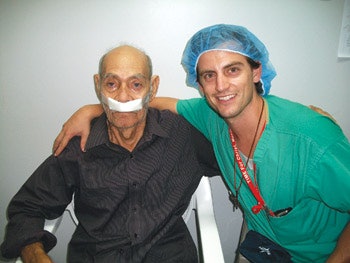 One of our patients after endoscopic sinus surgery to remove severe polyp disease with Steve Nogan.
One of our patients after endoscopic sinus surgery to remove severe polyp disease with Steve Nogan.We performed approximately 65 surgeries over the course of four days and distributed hundreds of medications. The operating rooms were fully staffed by U.S. volunteers, and we received additional, incredible support from Honduran physicians, nurses, translators, and security guards throughout the week. Operations included tonsillectomies, adenoidectomies, septoplasties, endoscopic sinus surgery, endoscopic laryngeal surgery, Sistrunk procedures, tympanoplasties, a thyroidectomy, a parotidectomy, and various soft tissue excisions.
Having done some limited mission work in the past, the biggest surprise to me on this trip was the quality of the facility. In an area where the local residents had no clean water and inadequate plumbing and electricity, we were able to operate in a facility that met U.S. standards in these capacities. This was truly extraordinary. Because of the high quality of the hospital and, more important, the high character of the Honduran and American volunteers involved, I know we were able to impact the patients in a big way and will continue to do so on future trips. Our friendships with the missionaries and permanent volunteers at the hospital and nearby orphanages will allow us to accurately gauge our impact throughout the coming year and improve the effectiveness of the care we will provide in Honduras going forward.
In the big picture of international surgical mission work, there will never be two experiences that are the same, neither in the impact on the volunteer nor the impact on the patients. In many instances, the long-term effectiveness of a short-term experience is difficult to measure, making evaluation and validation of our work challenging. Furthermore, it is impossible to account for all variables in this type of setting. Things like safety, natural resources, medical equipment, and surgical
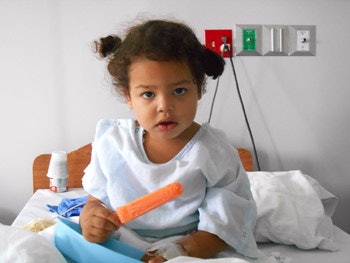 One of our pediatric patients enjoys a treat after surgery.
One of our pediatric patients enjoys a treat after surgery.complications can change or arise in an unpredictable fashion, all of which can have an impact on patient care. However, I do believe there are aspects of this type of mission work that you can control. Strong leadership, high character, and loyalty to the cause and the patients are the most important of these and can overcome the inevitable challenges of short-term mission work.
Much thanks to Baptist Medical & Dental Mission International (BMDMI), our sponsoring organization, for hosting us during our week in Honduras and the AAO-HNSF Humanitarian Efforts Committee for graciously helping with funding.




